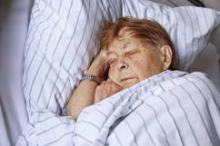Preclinical beta-amyloid deposition in the brains of cognitively normal volunteers was associated with poor sleep quality but not sleep quantity in a study published in the May issue of JAMA Neurology (formerly Archives of Neurology).
"Our findings support the hypothesis that sleep-wake abnormalities are associated with the presence of amyloid deposition in the preclinical stage of AD [Alzheimer’s disease]," wrote Dr. Yo-El Ju of the Charles F. and Joanne Knight Alzheimer’s Disease Research Center, Washington University, St. Louis, and her associates.
In addition, "our findings may expand the temporal window during which sleep abnormalities are identifiable and potentially modifiable in AD," they noted.
Dr. Ju and her colleagues observed that sleep-wake problems are common in AD, and that early in its course, the disease affects brain regions and pathways important for sleep and wake mechanisms. "Even in mild cognitive impairment, or very mild dementia, there are abnormalities in sleep architecture and electroencephalography measures.
The investigators assessed the sleep of 142 research volunteers aged 45-75 years (mean age, 66 years) using 2 weeks of actigraphy and sleep diary records. They recorded total sleep time, sleep efficiency (sleep time divided by time in bed), and wake time after sleep onset. Some had a parental history of symptomatic AD and were participating in longitudinal studies of healthy aging and dementia. All the study subjects scored 0 on the Clinical Dementia Rating.
Overall, 32 participants (22.5%) had a cerebrospinal fluid level of amyloid beta 42 of less than 500 pg/mL, indicating a strong likelihood of amyloid deposition in the brain.
Study subjects with a strong likelihood of amyloid deposition had significantly worse sleep efficiency (80.4% vs. 83.7%) than did those without amyloid deposition. This association remained significant when the data were adjusted to correct for age, sex, and apolipoprotein E epsilon-4 allele carrier status.
This difference in sleep efficiency also was significant in a subgroup analysis involving only the 100 study subjects who reported that their sleep had not changed during the preceding 5 years.
Wake time after sleep onset also was significantly higher (worse) among subjects with a strong likelihood of amyloid deposition than it was among those without it (63.1 min vs. 54 min).
In contrast, there were no differences between these two study groups in sleep quantity.
The participants with amyloid deposition showed a trend for spending more nonsleeping time in bed, but the trend didn’t reach statistical significance. Similarly, they reported taking more naps per week, but the difference between the groups’ average number of naps didn’t reach statistical significance.
However, "when we looked at the proportion of frequent nappers, defined as those taking naps on 3 or more days per week, this was significantly higher in the group with amyloid deposition, compared with the group without amyloid deposition (31.2% vs. 14.7%)," Dr. Ju and her associates wrote (JAMA Neurol. 2013;70:587-93).
This study could not determine causality. Amyloid deposition could cause sleep-wake disruption through several mechanisms, such as direct interference with neuronal function in areas of the brain that are critical for sleep. But poor sleep could just as well contribute to amyloid deposition, such as by increasing neuronal activity to a pathological degree, which is thought to facilitate deposition. It is likely that both of these processes play a role in a kind of positive feedback loop, the investigators said.
The findings of this study lay important groundwork for future research. "Longitudinal follow-up with ongoing measurement of amyloid and sleep should enable us to begin to tease apart the details of the abnormalities in sleep that begin to occur with the onset of AD pathology, as well as the directionality of the relationship between sleep and amyloid deposition," they noted.
If sleep disruption is found to raise the risk of future AD, "then this provides an even stronger motivation to identify and treat individuals with sleep disorders, such as obstructive sleep apnea," Dr. Ju and her colleagues added.
This study was supported by grants from the U.S. National Institutes of Health, the Ellison Medical Foundation Senior Scholar Award, and the National Center for Research Resources. Dr. Ju reported no financial conflicts of interest, but some of her associates reported ties to UCB, Jazz Pharmaceuticals, and other companies.


